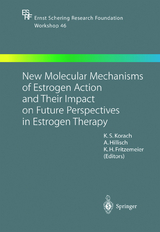New Molecular Mechanisms of Estrogen Action and Their Impact on Future Perspectives in Estrogen Therapy
Springer Berlin (Verlag)
978-3-540-40250-3 (ISBN)
- Keine Verlagsinformationen verfügbar
- Artikel merken
1 Estrogens: From Classical Endocrine Action to Tissue Selective Action.- 2 Identification of RIP140 as a Nuclear Receptor Cofactor with a Role in Female Reproduction.- 3 A Structural Explanation for ER?/ER? SERM Discrimination.- 4 Protein Structure-Based Design, Synthesis Strategy and In Vitro Pharmacological Characterization of Estrogen Receptor ? and ? Selective Compounds.- 5 How to Understand Estrogen Signaling from the Phenotypes of ERa and ERb Knockout Mice.- 6 Mechanisms of Estrogenic Effects on Neurobiological Functions.- 7 Role of Estrogens in the Male Reproductive Tract.- 8 Are Estrogens of Importance to Ovarian Function?.- 9 Biological Effects of ER? and ER? Selective Estrogens.- 10 The ERE-luc Reporter Mouse.- 11 Role of Estrogens in Ovarian Dysfunction and Fertility. Options for New Therapies with SERMs.- 12 Estrogens and Atherosclerosis.- 13 Hormone Replacement (Therapy): A Time for Interrogation, Information and Further Studies.- Previous Volumes Published in This Series.
| Erscheint lt. Verlag | 21.6.2004 |
|---|---|
| Reihe/Serie | Ernst Schering Foundation Symposium Proceedings |
| Zusatzinfo | XVI, 214 p. 94 illus., 12 illus. in color. |
| Verlagsort | Berlin |
| Sprache | englisch |
| Maße | 152 x 223 mm |
| Gewicht | 435 g |
| Themenwelt | Medizin / Pharmazie ► Medizinische Fachgebiete ► Pharmakologie / Pharmakotherapie |
| Medizin / Pharmazie ► Pharmazie | |
| Schlagworte | drug discovery • Endokrinologie • estrogen action • Estrogen Receptor • Hormone Replacement Therary • Östrogen • Steroid Hormones • Structure Biology • tissue |
| ISBN-10 | 3-540-40250-0 / 3540402500 |
| ISBN-13 | 978-3-540-40250-3 / 9783540402503 |
| Zustand | Neuware |
| Haben Sie eine Frage zum Produkt? |
aus dem Bereich




